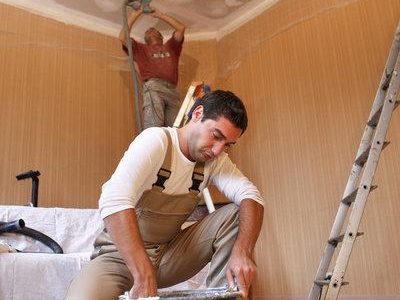The Facts About Plasterer Revealed
Wiki Article
Plasterer Can Be Fun For Everyone
Table of ContentsThe Greatest Guide To PlastererThe 20-Second Trick For PlastererThe Buzz on PlastererThe Only Guide to Plasterer
Normally the professional has actually already supplied all the bags of Gypsum plaster that will certainly be required, as well as any outside supply of water if your home is not yet attached. The plastering staff requires to bring their very own tools and equipment and occasionally supply their very own bead. The Tasks that the plasterer is generally expected to accomplish.

In position where greater than one corner satisfies; the grain's ends are cut at an angle as well as the 2 or even more suggestions are positioned as close with each other as allowed; touching yet not overlapping. The grain is entirely covered with plaster as well as the rest of the wall surface as well as the plaster also aids to hold it firm.
This leaves a tidy, straight looking edge. An alternative method seen in older homes of developing a rounded or bullnosed corner makes use of a quirked wood team grain. The personnel bead, a 1-inch dowel with approx 1/3 slashed off the back, is set on the exterior corner by the joiner on site, attached to wooden plugs set right into the brick/block joints, or to the timber framework.
Things about Plasterer
The quirk will certainly conceal the ultimate small split that will develop between the staff grain and also plaster. The plasterer needs to load a 5-gallon bucket partway with water. From this container he hangs his trowel or trowels as well as areas right into it various tools. Generally a plasterer has one trowel for "laying on" (the process of putting mud onto the wall).A lay-on trowel tends to be too flat for this as well as the vacuum triggered by the water can argue the wall surface, requiring him to tear it off as well as therefore he has to remodel the area. One may have a brand name new trowel "not yet broken-in" which he will made use of for "grinding"; this is when the plaster is virtually set as well as he is smoothing out any type of bumps or filling in any tiny dips (pet cat deals with) to make the wall look like an uniform sheet of shiny white plaster.
some wield trowels as large as 20 inches long yet the standard appears to be a 16"5". From my experience the recommended brand name is a Marshalltown stainless steel. They have a brassy radiance to them, a rubber manage and won't match or rust if inadvertently left in water over night while others choose a regular take trowel which calls for more maintenance but lasts for quite a lengthy why not try these out time and the matching can offer it a "attack" that aids when "ending up" (the last pass when the plaster is establishing).
These device containers are very first kept near the mix table and afterwards as the plaster begins to set are moved better to the wall that is being worked on. Time becomes a large variable below as when the plaster starts to solidify (collection) it will do so relatively swiftly as well as the plasterer has a small margin of mistake to obtain the wall smooth.
The Main Principles Of Plasterer
Any type of debris in the plaster can become a major nuisance. Plasterers will normally separate a room, (especially a large or high-ceilinged wall) into top as well as bottom. The one servicing top will certainly do from the ceiling's side to concerning stubborn belly height as well as sweat off a milk crate for an 8-foot (2.The homeowner and the plasterer's boss will typically choose ahead of time what styles they will utilize in your home. Normally wall surfaces are smooth and also occasionally ceilings. Usually a property owner will opt to have the ceilings utilize a "texture" technique as it is a lot easier, faster, and thus less expensive than a smooth basics ceiling.
The board feet is obtained by the wall mounts or estimated by the head subcontractor by counting the wallboards that come in a market standard of 8' to 12' long. Normally if the ceiling is to be smooth it is done first, prior to the walls.
The factor for this is that inevitably when a ceiling is being worked with plaster will certainly drop and also sprinkle onto the walls. A structure mix doesn't need to be smoothed out when it begins to set: thus a resistant such as "Lotion of tartar" or sugar can be utilized to prolong the setup time, and is easily scraped off the wall surfaces.
A Biased View of Plasterer
another reason is that a bird is typically run along the top corner after doing a smooth ceiling, then it is less complicated to maintain this edge by doing the wall last. But a textured ceiling usually does not need to be birded, only mixed in with an extremely damp paint brush.The initial thing the plasterer often tends to do is look at all the mesh-taped seams of the wall surfaces he will cover; in a very slim swatch - Plasterer. The wallboard draws dampness out of this strip so when the plasterer goes over it once more when doing the remainder of the wall surface it will certainly not leave an indented joint that needs additional reworking.
This conserves a lot needed time as this procedure is a race versus the chemical response. From the mix table the plasterer scoops read this article some "mud" onto the facility of his hawk with his trowel. Holding the hawk in his off-hand and his trowel in his primary the plasterer then scoops a bulging roll of plaster onto his trowel.
Report this wiki page